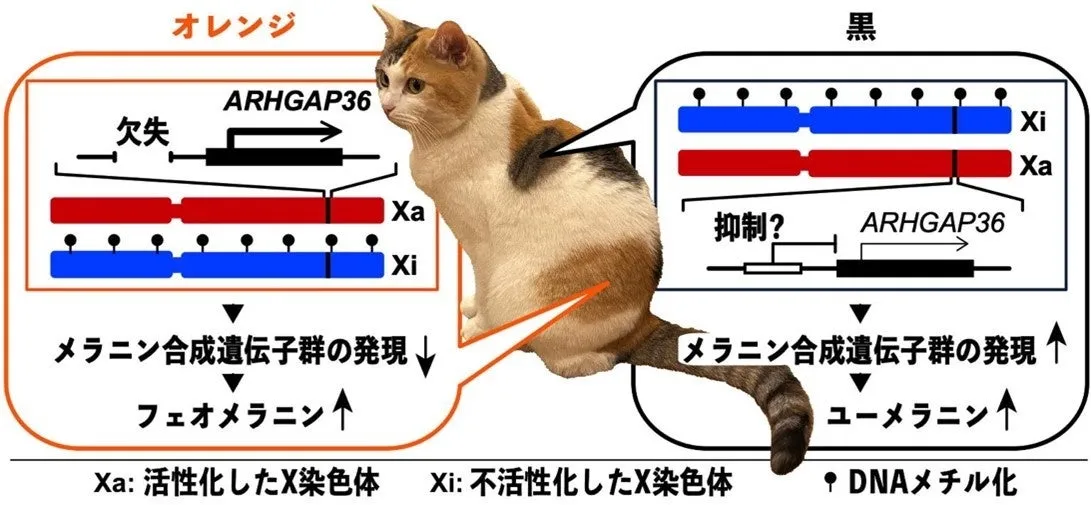

Breakthrough Discovery on the Gene Determining Coloring in Calico Cats
The Intrigue of Calico Cats
Calico cats and tortoiseshells have long captivated pet lovers and scientists alike, primarily due to their striking colors and the peculiar fact that almost all of them are female. For over a century, it has been known that the gene determining orange and black coloring is located on the X chromosome. However, the specific gene responsible had remained unidentified until now.
Unveiling the Mystery
A dedicated research team from Kyushu University, including Professor Hiroyuki Sasaki, have finally pinpointed the gene responsible for the orange coloration in these cats: the ARHGAP36 gene. This marked a significant breakthrough in understanding feline genetics and presented a clear link to the established theories surrounding the coat coloration of these unique felines.
The research uncovered that in cats with orange fur, approximately 5,000 base pairs were deleted from the ARHGAP36 gene region on the X chromosome. This deletion was found to correlate directly with the presence of orange fur, confirming hypotheses that had been posited over 60 years ago but had never been substantiated.
The Research Findings
To reach this conclusion, the research team analyzed the DNA of 18 cats with various fur colors in Fukuoka City. They then compared their findings with over 50 additional cats, including some from international databases. Importantly, their analyses indicated that the presence or absence of the deletion in the ARHGAP36 gene aligned perfectly with the presence of orange fur. The research also suggested that this deletion region harbors highly conserved sequences across animal species, leading to the hypothesis that it regulates the expression of ARHGAP36.
Further exploration revealed that the skin with orange fur showed elevated expression of the ARHGAP36 gene, which, interestingly, correlated with decreased expression of the genes associated with melanin synthesis. This suppression suggests a crucial shift from the production of eumelanin (which gives a black coloration) to pheomelanin (the pigment responsible for orange coloration).
Scientific Significance
The implications of this study extend beyond just understanding cat coloration. It stitches together a broader narrative regarding genetic expression and epigenetics, particularly the X chromosome's role in trait manifestation among female mammals. The phenomenon, known as X chromosome inactivation, has been a cornerstone of genetic understanding since the hypothesis proposed by Dr. Mary Lyon in 1961. Yet, this recent effort provides a tangible molecular underpinning to the longstanding theories.
The ARHGAP36 gene's importance in this context is not limited to feline genetics; its parallels in human genetics suggest that understanding this gene could contribute to insights into various human diseases, including certain tumors and congenital diseases.
Looking Forward
Moving forward, the team anticipates unraveling even more complexities linked to the ARHGAP36 gene. Studies utilizing high-quality iPS cells from cats may shed light on the mechanisms by which this gene influences melanin production.
Additionally, the homogeneity of this genetic mutation in orange-haired cats globally points to a singular historical origin that warrants further exploration. By examining ancient cat artwork and remnants, researchers hope to pinpoint the timeline and location of this gene's mutation in the feline lineage.
Conclusion
The recent findings are not just a victory for academic inquiry but also an acknowledgment of the mysteries still embedded within the tapestry of genetics. As the research progresses, it promises to illuminate the pathways of evolutionary biology, enhancing appreciation for both domestic cats and their wild counterparts.
This pioneering research has found its place in the annals of genetic literature, published in the journal Current Biology. This collaborative effort signifies a major advancement in understanding not just the whimsy of cat colors but the intricate dance of genetics at play in nature.
The research was supported in part by crowdfunding efforts through Kyushu University, underscoring the significance of community in scientific discovery.





Topics Other)










【About Using Articles】
You can freely use the title and article content by linking to the page where the article is posted.
※ Images cannot be used.
【About Links】
Links are free to use.